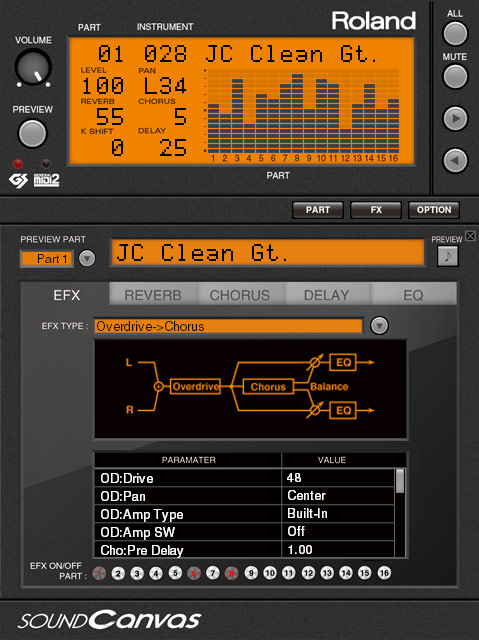When you think of General MIDI and General Standard, you probably think of Sound Canvas.
Very few General sound modules have achieved the legendary status of the Roland Sound Canvas SC-88. Released in 1994, it quickly became a go-to choice for musicians and producers everywhere.
With its impressive range of features and high-quality sounds, the SC-88 was truly a product that defined an era.

What Was the Roland SC-88?
The Roland SC-88 was a half-rack unit sound module released by Roland in 1994. It was part of the Sound Canvas series, which was first introduced in 1991. Designed as a compact and versatile unit, the SC-88 offered musicians a wide range of sounds and features in a convenient package. Its popularity quickly soared, making it a staple in the music production world.
This vintage sound module was the de facto gold standard for General MIDI sound processing. It offered over 600 sounds, 32-part multitimbrality, and a host of other features that made it a dream machine during the '90s.
Roland SC-88 Features
The Roland SC-88 boasted an impressive array of features that set it apart from its competitors. Let’s take a closer look at some of its key features:
32-Part Multitimbrality
Throughout the ‘70s and ‘80s, most synthesizers and modules could only play one sound at a time. But the SC-88 offered 32-part multitimbral capabilities. In other words, you could play up to 32 different sounds simultaneously.
It’s a feature we take for granted today in our DAWs. But at the time, having one machine that could replicate every instrument in the orchestra at once was a game changer.
As such, the SC-88 allowed users to create more rich and complex compositions. Whether you were crafting detailed orchestral arrangements or intricate electronic soundscapes, the 88 provided the versatility needed to bring your musical visions to life.
64-Voice Polyphony
With 64 voices of polyphony, the SC-88 offered ample room for expressive playing without worrying about notes dropping out. This ensured smooth and uninterrupted musical performances, making it an ideal choice for both live and studio applications.
654 Preset Sounds & 24 Drum Kits.
One of the most enticing aspects of the SC-88 was its extensive library of sounds. With 654 high-quality preset sounds and 24 drum kits, it offered a wide sonic palette for musicians to explore.
Many of the sounds were recycled from its predecessor, the SC-55. As such, it offered backwards compatibility for programs originally mapped for the SC-55.
Built-In Effects
To further enhance the sonic possibilities, the SC-88 came equipped with a variety of built-in effects. It offered eight types of reverb, eight types of chorus, ten types of delay, and other effects that allowed users to add depth, character, and ambience to their sounds. These effects could be fine-tuned by specifying parameters, giving musicians precise control over their creations.
The Roland SC-88 Pro
Building upon the success of the SC-88, Roland released an upgraded version called the SC-88 Pro in 1996. The Pro had nearly double the number of onboard sounds and introduced several improvements over its predecessor. With these advancements, the SC-88 Pro offered musicians even more possibilities to explore and expand their musical horizons.

Software Alternatives to the Roland SC-88
While the Roland SC-88 holds a special place in the hearts of many musicians, there are some modern software alternatives that capture its essence.
If you’re looking for a Roland SC-88 VST or soundfont, either of these official plugins will do the trick.
Roland Sound Canvas VA
Roland Sound Canvas VA is a VST version of the Roland Sound Canvas product line. This instrument faithfully recreates the sounds and functionality of the original SC-88 and its subsequent iterations. Plus, it contains over 1600 instruments, 64 effects, and a host of other sound design capabilities.
Cakewalk TTS-1
Many versions of Cakewalk Sonar included a rebranded version of the Virtual Sound Canvas called TTS-1. This software instrument includes all the sounds found in the SC-88. If you have Cakewalk by Bandlab or an earlier version of Sonar, you have TTS-1.
Keep in mind, TTS-1 is a DXi plugin and not a VST. So unless you’re using Cakewalk, your DAW may have some compatibility issues with it.
- Based on Cakewalk's legacy Sonar DAWs
- Professional-level features for audio editing, mixing, and mastering
- Integrates with Bandlab's online DAW
- Dozens of FX plugins and ProChannel modules
- Free to download
- MIDI editing is a bit clunky
- Only available for Windows


